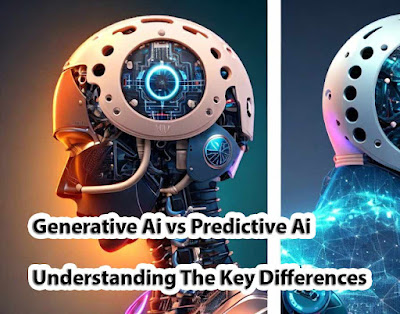
Two distinct branches of artificial intelligence hold
transformative potential - predictive AI analyzes historical datasets for
data-driven forecasting while generative AI creates novel content
synthetic creativity. Though often grouped under a broad "AI"
label, comprehending the unique value of predictive vs generative systems
allows matching needs.
We contrast these methodologies across various dimensions:
How Predictive AI Works
Predictive analytics utilize statistical and machine
learning algorithms to uncover patterns within structured data, identifying
signals and correlations that determine probable outcomes.
For instance, an insurance firm may leverage predictive AI
to derive insights like:
- Which
policyholders have highest risk of accidents based on age, location etc.
allowing personalized pricing
- Optimal
premium thresholds to remain profitable across geographies
- Expected
payout costs next year given weather forecasts
This foresight from predictive models enhances data-driven
decision making. Think having a trusted statistician crunching numbers to
advise on most likely scenarios so you can strategize accordingly.
When Generative AI Gets Creative
Generative AI refers to machine learning techniques
like GANs and diffusion models that create novel content like images, audio,
text and video from scratch rather than analyzing existing patterns.
Applications include:
- Deepfakes:
Blending celebrity faces via generative adversarial networks to output
manipulated video and imagery
- AI
Art: Generating unique paintings with varying styles after training on
artist portfolios
- De
Novo molecule generation: Designing new molecular structures with
desired pharmacological properties
Rather than logical number-crunching, generative AI aims to
replicate the imaginative, creative faculties of the human mind.
Key Differences Compared
|
Predictive AI |
Generative AI |
|
Evaluates historical data to uncover future probabilities |
Creates new content devoid of explicit inputs |
|
Enhances decision-making with likely outcomes |
Stimulates creativity by synthetically designing artifacts |
|
Strong at pattern recognition within structured data |
Excels with unstructured data types like images, text and
speech |
|
Looks backwards at data like an analyst advising
strategies |
Looks forwards to previously unavailable outputs like an
inventor |
Real World Impact
Understanding these AI branches facilitates matching
applications. While their implementation is gathering momentum, focusing
investment as per strategic needs is advised over getting swayed by hype cycles
without assessing organizational fit.
When Predictive Intelligence Suits
Enriching sales forecasts, predictive maintenance for
machinery, demand planning, credit evaluation, healthcare analytics etc.
exemplify use cases benefitting from predictive analytics. Where historical
datasets exists, unearthing correlations that inform deliberations is
invaluable.
Applications for Generative AI
Design ideation, synthetic media content for marketing, drug
discovery, even augmenting software developer productivity via auto code
generation reveal promising generative AI potential. For pioneering innovation
or automating tedious tasks, generative models bring customization with
boundless creativity.
An AI-Powered Future
Rather than an either-or choice, predictive and
generative models can complement organizations. While predictive AI empower
data-centric departments to get strategic, generative AI supports unleashing
enterprise-wide creativity for the next generation of inventions! Our synthesis
with artificial intelligence has only just commenced.
With artificial intelligence advancing at a dizzying pace,
comprehending fundamental differences between the major AI branches empowers
harnessing them judiciously. As explored in this article, predictive AI and
generative AI achieve extraordinarily distinct objectives.
While predictive AI sifts through structured datasets to
uncover probable future outcomes for enhanced decision-making, generative AI
develops strikingly innovative content and insights by creatively expanding on
previous works rather than extrapolating explicit patterns.
Notwithstanding the distinct pathways, thoughtfully
integrating these contrasting yet complementary approaches unlocks otherwise
unattainable solutions. With predictive intelligence informing critical
operations and generative creativity pioneering developments once solely conceivable
by human minds, the synergy of human and artificial imagination is poised to
transform every facet of life and business.
By grasping essential contrasts between generative AI vs
predictive AI models in terms of their value, applications and inner workings
as detailed here, you are now better equipped to leverage these phenomenal
technologies consciously towards goals matching your unique needs and
aspirations!
